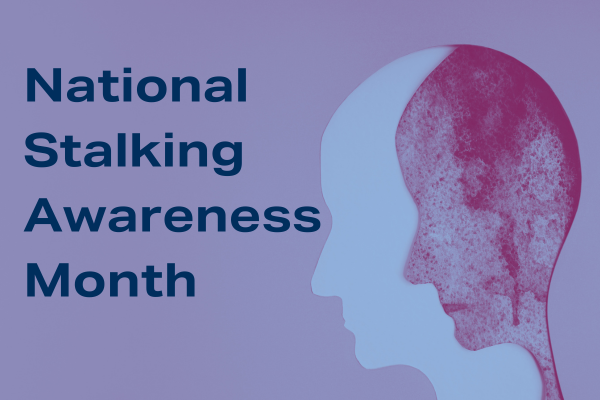January is Stalking Awareness Month. Stalking is defined as a pattern of behavior directed at a specific person that would cause a reasonable person to fear for their safety or suffer substantial emotional distress. While anyone can be a victim of stalking, most people who experience stalking are women. As noted in the presidential proclamation on National Stalking Awareness Month, stalking affects one in three women and one in six men in their lifetimes in the U.S.
Stalking is a serious behavior that often goes hand in hand with other types of violence and abuse, including domestic violence. According to statistics from the National Coalition Against Domestic Violence, 76% of women murdered by an intimate partner were stalked first. Unfortunately, it’s often unrecognized by both responders, like law enforcement, service providers, and attorneys, as well as the victims of stalking themselves.
People experiencing stalking, particularly immigrant populations, will typically not use the word “stalking” to describe what they are experiencing. Everyone responds to stalking differently, which can also make it harder to identify. Some people may feel afraid while others may appear more irritated, angry or show no emotion at all. Many people being stalked will minimize it, but stalking can be very dangerous, and behaviors can escalate.
As service providers, the most effective way to identify if stalking is occurring is to ask questions about specific behaviors. The Stalking Prevention, Awareness, and Resource Center (SPARC) has identified four categories of threatening behaviors that can be classified as stalking:
- Surveillance
- Life invasion
- Intimidation
- Interference through sabotage or attack
Stalking behaviors may also show up differently for people in immigrant communities. As with other types of abusive behaviors, stalkers may exploit immigrants’ cultural differences, undocumented or temporary immigration status, limited English proficiency, and lack of knowledge or understanding of U.S. laws and legal protections.
When an immigrant experiencing stalking seeks help, they often face additional barriers accessing resources. Law enforcement, victim services, and attorneys may not be equipped to provide adequate language access or culturally specific support services, and may not be knowledgeable about immigrants’ legal rights.
Here are specific examples of the four categories of behavior and how they may show up particularly for immigrants experiencing stalking.
Surveillance
Surveillance is the most commonly identified stalking tactic and includes watching and gathering information about the person being stalked. Examples of surveillance for an immigrant victim of stalking include:
- Leveraging a small, tight-knit immigrant community to monitor the person being stalked and gather information about the person from community members.
- Frequenting businesses, neighborhoods, or online spaces known for attracting immigrant community members to find or wait for an immigrant victim.
- Taking advantage of privilege as an English speaker to communicate on behalf of the victim and gain access to private or confidential information and places (such as a doctor’s office).
Life Invasion
SPARC defines life invasion as ways that the offender shows up in the victim’s life without the victim’s consent. For an immigrant being stalked, this could look like:
- Purposely and publicly mispronouncing the person’s name or using a name they don’t want to be used.
- Publicly using anti-immigrant slurs against the person, or more specific slurs against their culture, country of origin, religion, or ethnic/racial background.
- Showing up at culturally-specific, faith-based, or immigrant events, knowing the victim will be there.
- Creating online profiles of the victim with the intent to humiliate them and/or ruin their reputation in culturally-specific, faith-based, or immigrant groups and spaces.
Intimidation
Some specific examples of intimidation for an immigrant victim of stalking include:
- Threats to interfere with immigration processes, such as by withdrawing petitions or papers, failing to file immigration papers for the victim, or making false allegations on legal forms filed on their behalf.
- Threats to report the victim, their children, or their family members to immigration.
- Threats to destroy important documents (e.g. birth certificates, passports, immigration documents, ID cards/documents).
- Threats to destroy items from the victim’s country of origin are important to them.
- Defacing their property with anti-immigrant epithets or slurs (or more specific slurs against their culture, country of origin, ethnic/racial background).
- Threats to ruin the person’s reputation with their immigrant/cultural community in the U.S. and/or in their home country.
- Threats to take children away, or to deport the children or the victim from the U.S.
Interference
Interference through sabotage or attacks moves from intimidating threats to actions. Here are some examples of ways a stalker might interfere in an immigrant victim’s life:
- Interfere with the immigration process. This could include withdrawing petitions or papers, failing to file immigration papers for the victim, making false allegations on legal forms filed on the victim’s behalf, and lying about the victim’s immigration status.
- Damage or destroy documents vital to the victim’s immigration status or process.
- Force the victim to sign papers in English they do not understand, such as immigration papers or court papers.
- Spread rumors or ruin the victim’s reputation with their immigrant/cultural community in the U.S. and/or in their home country.
- Use the victim’s immigration status and/or cultural identity as part of emotional and psychological abuse.
If you are being stalked, there are actions you can take to help protect your safety. Keep a log documenting any incidents with your stalker that made you feel afraid or uncomfortable. SPARC offers templates for a stalking incident log on their website in both English and Spanish. Save as much evidence as possible, including voicemails, texts, and letters. Call the National Domestic Violence Hotline at 1-800-799 -7233 for more information and help.
References
SPARC, “Stalking Behaviors Targeting Immigrant Victims,” available at: https://www.stalkingawareness.org/wp-content/uploads/2023/08/SPARC-Stalking-Targeting-Immigrant-Victims.pdf
National Domestic Violence Hotline, “Stalking Safety Planning,” available at: https://www.thehotline.org/resources/stalking-safety-planning/
The White House, “A Proclamation on National Stalking Awareness Month, 2024,” available at: https://www.whitehouse.gov/briefing-room/presidential-actions/2023/12/29/a-proclamation-on-national-stalking-awareness-month-2024/#:~:text=NOW%2C%20THEREFORE%2C%20I%2C%20JOSEPH,as%20National%20Stalking%20Awareness%20Month.

